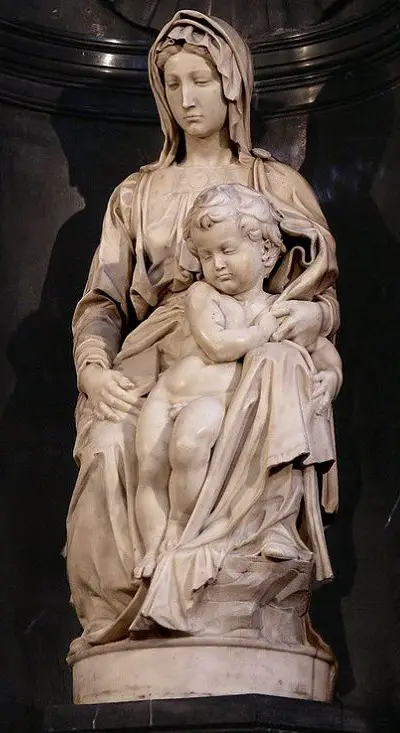It was created in about 1504 and measures 4 feet 2.5 inches. Upon completion, the sculpture was taken to the Flemish city of Bruges by the wool merchant who commissioned it, hence the name by which it is now known. It is thought that the sculpture was intended to be placed on an altar.
Michelangelo takes a different approach to his predecessors when representing this often-depicted scene. Earlier artists portrayed the Madonna as holding the child in her arms whilst lovingly looking down on him. Though Michelangelo's Mary is also looking down, her gaze is directed away from the child.
She sits upright in a regal manner, as though she is a queen on the throne. Though her face seems devoid of emotion, it is not because she feels nothing for her child - rather, she is doing her best to remain stoic, sensing the tragic inevitability of her child's fate.
The Christ child, meanwhile, stands in front of his mother with only a little support from her hand. His upright posture seems to suggest that he is destined to become a leader - he looks prepared to step forward into the world and embark upon his mission. His expression too is serious rather than playful - unlike previous artists, Michelangelo did not attempt to make the child look cherubic or charming.
Some theorise that the child is standing in front of his mother's womb to emphasise that she is the mother of God. It could also be an aesthetic matter - there is a clear contrast between the textured folds of Mary's dress and the smooth skin of her child.
Both mother and child seem to be aware of an invisible congregation of worshippers. Michelangelo may have intended to portray the two figures as divine, looking down on humankind. It's almost as if Mary, in the role of a queen, is exhibiting the Christ child to her subjects.
It is believed that parts of the stones and drapery on the sculpture were carved by one of Michelangelo's assistants rather than the artist himself. This has led some to say it is a 'doubtful work' of Michelangelo, though this is not a widely held view.
Madonna of Bruges was the only Michelangelo sculpture to be transported outside Italy in his lifetime. However, it has also left Belgium twice. In 1794 it was sent to Paris after the Austrian Netherlands were conquered by the French Revolutionaries. It was brought back to Belgium after Napoleon's defeat, before being removed once again by German soldiers during World War II. After being returned to Belgium for the final time, it was placed in The Church of Our Lady in Bruges.
Madonna of Bruges is often compared to Pietà, a Michelangelo sculpture completed five years earlier. This sculpture shows Christ's body sprawled in his mother's lap after the crucifixion. There are many similarities between the two - these are most prominent in Mary's facial features, bowed head and flowing dress. She wears the same solemn expression in both sculptures, reflecting her son's tragic fate.
Interestingly, she is portrayed as a young woman in both pieces, though she would have been middle-aged at the time of her son's death. It is said that Michelangelo intended to convey her purity and chastity by preserving her youthfulness. Though the similarities between the two sculptures are undeniable, the Bruges Madonna differs from Pietà in that is more compact and arguably more elegant.
There is also some similarity between Madonna of Bruges and the Pitti Madonna, another work by Michelangelo. The two were sculpted around the same time and are similarly composed. The same model even appears to have been used for the Christ child.
When compared to the Bruges Madonna, the most striking thing about the Pitti Madonna is that the child is smiling and carefree. His mother, on the other hand, appears to be looking over her shoulder as if she senses the danger awaiting her child. This again contrasts with Mary's impassive expression in Madonna of Bruges.
Michelangelo's Pietà was attacked and damaged in 1972, and as a consequence Madonna of Bruges was placed behind bulletproof glass. Members of the public are no longer allowed within fifteen feet of the sculpture.


